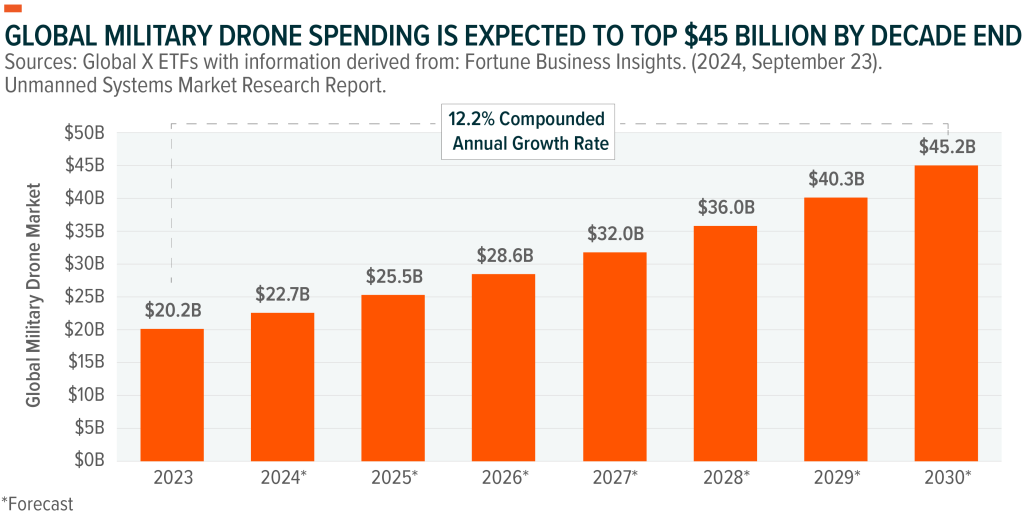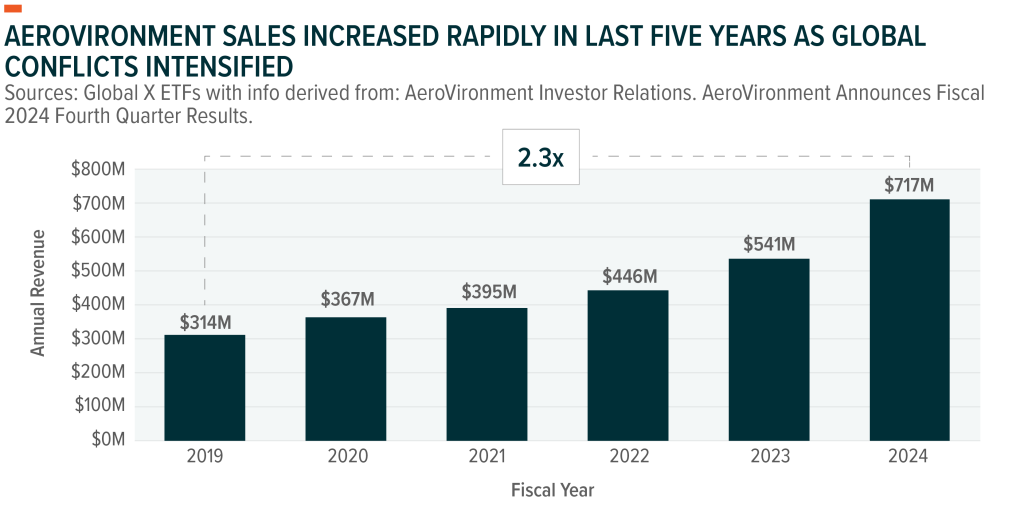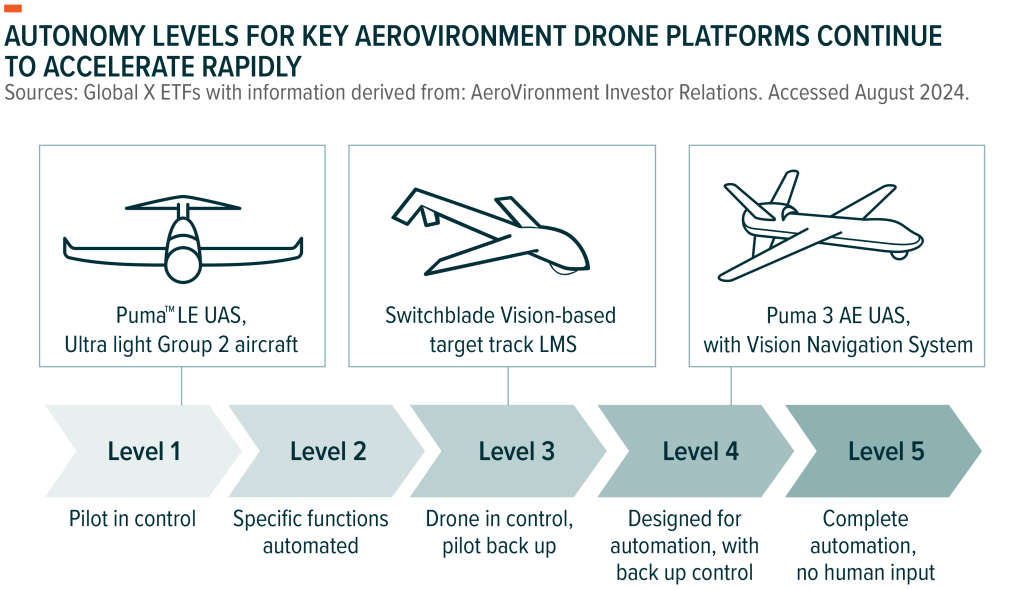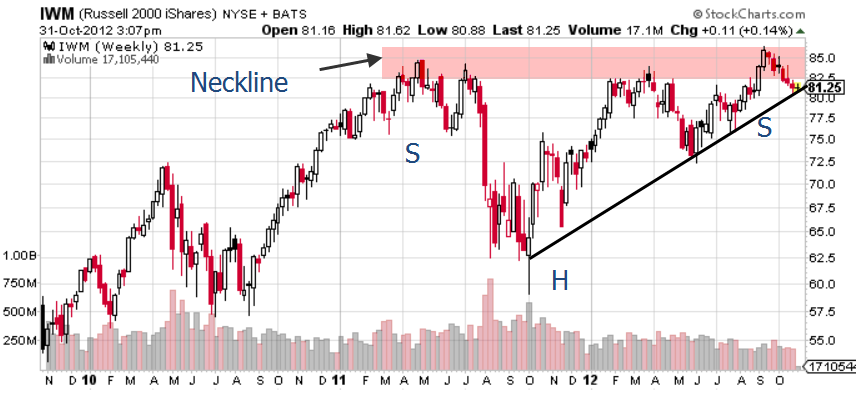By: Ido Caspi
The growing use of drones is transforming warfare. Though their use on the battlefield dates back as far as World War I, recent conflicts, along with technological advancements and declining prices, have greatly expanded their deployment and use cases.1 Unlike traditional military assets, drones can operate from a distance, at a fraction of the cost, and with increasing precision. Particularly with the integration of increasingly autonomous technologies, drones priced under a million dollars are capable of neutralizing high-value targets such as tanks and warships. Growing evidence of efficacy and the accelerating use of drones will likely fuel a specialized value chain of manufacturers, software developers, and AI innovators, all working to enhance the capabilities of these systems, potentially driving a surge in global military drone spending.

Key Takeaways
- Unmanned aerial vehicles (UAVs) have evolved from niche tools into essential assets on the battlefield, offering invaluable capabilities in surveillance, reconnaissance, and precision strikes that reshape traditional military strategies.
- The affordability and versatility of drones have shifted the balance of power in conflicts, allowing less financially resourced forces to compete with larger, wealthier militaries.
- We anticipate nations to increasingly embrace a breadth of drone-based reconnaissance as well as attack solutions, prompting significant investments in UAVs as critical components of modern defense systems.
Drone Technology Levels the Playing Field for Less Financially Resourced Armies
In military conflicts, minimizing costs and soldier casualties are key. Using fewer resources and undertaking fewer casualties to achieve objectives is always advantageous. Traditionally, military spending focused on acquiring top-tier hardware and maintaining ample ammunition supplies, giving wealthier nations a strategic edge. However, recent technological advances have made drone systems more sophisticated and affordable, enabling them to compete with far more expensive defense apparatuses, thus leveling the playing field in favor of less resourced combatants. Today, drones costing as little as $500 can effectively neutralize costly artillery pieces or tanks worth millions of dollars, limiting physical human presence on the battlefield and preserving human life.2
The deployment of drone technology by both Ukrainian and Russian forces demonstrates the rapid advancement of unmanned aerial systems. First-person view (FPV) drones have emerged as a particularly cost-effective solution, operating effectively in areas with sophisticated air defense systems. These remotely piloted systems represent significant cost savings compared to traditional equipment, leading Ukraine to set production targets of one million FPV units in 2024 – roughly double the equipment supplied by the European Union in the previous year.3
Long-range drone systems have also proven economically advantageous in the region. While unit costs range from thousands to hundreds of thousands of dollars, they demonstrate strong cost-efficiency compared to conventional air defense systems. Both Ukrainian and Russian forces have deployed UAVs capable of reaching targets 700-1000 kilometers away, with platforms like the Shahed system exemplifying this extended range capability while maintaining relatively low production costs.4
Global Drone Adoption Fuels Further Innovation Amongst Industry Heavyweights
AeroVironment, a U.S. based defense contractor, is emerging as a leading pureplay unmanned systems company, designing and manufacturing unmanned aircraft systems (UAS), unmanned ground vehicles (UGVs), and loitering munition systems (LMSs). AeroVironment is one of the largest suppliers of drones to the U.S. military, dating back to the introduction of its hand-portable UAVs in the mid 1980’s. Today, the company’s products are used by defense, government, and commercial customers around the world. Revenues are expected to approach $805 million for the fiscal year 2025, which would mark a 12% increase over 2024.5

Recently, the company inked a $1 billion contract with the U.S. Army to supply its Switchblade loitering munitions for infantry battalions.6 Switchblade drones combine surveillance capabilities like any other drone but can also be used as guided missiles capable of destroying tanks, light armored vehicles, hardened targets, and enemy personnel. The U.S. Army has used Switchblades for over a decade, and their effective deployment by Ukrainian forces has highlighted their broader strategic utility and favorable economics. The United Kingdom is the only other current Switchblade operator, but countries such as France, Lithuania, and Australia have all signed deals to purchase the system since war began in Ukraine.7
Lockheed Martin, for its part, was recently awarded a $6 million contract by the Defense Advanced Research Projects Agency (DARPA) to equip Black Hawk helicopters with drone-like capabilities, enabling un-crewed flight operations.8 Anduril Industries, a prominent private defense technology company, launched its Bolt lineup of drones, including the Bolt-M, a loitering munition system capable of being armed with a warhead weighing up to 3 pounds.9 Combined, these developments demonstrate how rapidly this market is reshaping warfare.
Drone technology is expected to advance rapidly in the coming years. Ongoing conflicts mean that new advancements are battle tested quickly and manufacturers receive feedback almost in real time. Today, most drones are operated manually, but many are taking incremental steps toward automation. With strong demand and the integration of increasingly sophisticated artificial intelligence systems, achieving level 5 automation is likely a question of when, not if. This could be another potential tailwind to accelerate drone spending.

Conclusion: Effective, Cheap, and Widespread
The rise of UAVs has fundamentally reshaped the landscape of modern warfare, leveling the playing field between well-funded militaries and those with more limited resources but greater technological sophistication. The integration of drones into military strategies has shifted focus from traditional, high-cost hardware to agile, versatile systems capable of delivering precision strikes while minimizing human casualties. As emerging conflicts illustrate, the strategic deployment of both short- and long-range UAVs is not just a tactical advantage but a transformative shift in the nature of warfare. Innovative companies like AeroVironment are at the forefront of this shift, proving that the future of warfare lies in the hands of those who can adapt quickly to technological advances. Now more than ever, defense sectors and policymakers are likely to prioritize investment in innovative drone technologies to remain competitive and secure in this evolving geopolitical landscape.
Originally posted on November 4, 2024 on GlobalX blog
PHOTO CREDIT : https://www.shutterstock.com/ai-image-generator
VIA SHUTTERSTOCK
Footnotes
1. The National WWI Museum and Memorial. (n.d). Unmanned Drones Have Been Around Since World War I.
2. Reuters. (2024, March 26). How drone combat in Ukraine is changing warfare.
3. Ibid.
4. Ibid.
5. Aerovironment. (2024, September 4). AeroVironment Announces Fiscal 2025 First Quarter Results.
6. Defense News. (2024, August 28). Aerovironment wins nearly $1B to supply Switchblade munitions to Army.
7. Ibid.
8. Fort Worth Report. (2024, October 14). Lockheed company gets $6M contract to provide Black Hawks with drone capability.
9. The Defense Post. (2024, October 11). Anduril Introduces Bolt-M Autonomous Attack Drone.
DISCLOSURES:
Information provided by Global X Management Company LLC.
This material represents an assessment of the market environment at a specific point in time and is not intended to be a forecast of future events, or a guarantee of future results. This information is not intended to be individual or personalized investment advice and should not be used for trading purposes. Please consult a financial advisor or tax professional for more information regarding your investment and/or tax situation.
Investing involves risk, including the possible loss of principal. Diversification does not ensure a profit or guarantee against a loss. International investments may involve risk of capital loss from unfavorable fluctuation in currency values, from differences in generally accepted accounting principles, or from economic or political instability in other nations. Emerging markets involve heightened risks related to the same factors as well as increased volatility and lower trading volume. Narrowly focused investments may be subject to higher volatility. There are additional risks associated with investing in Gold and the Gold exploration industry.



